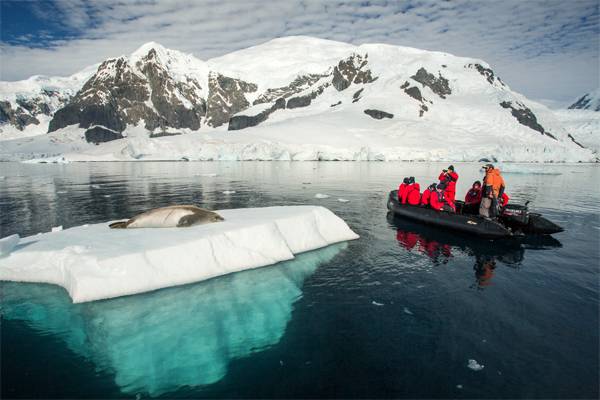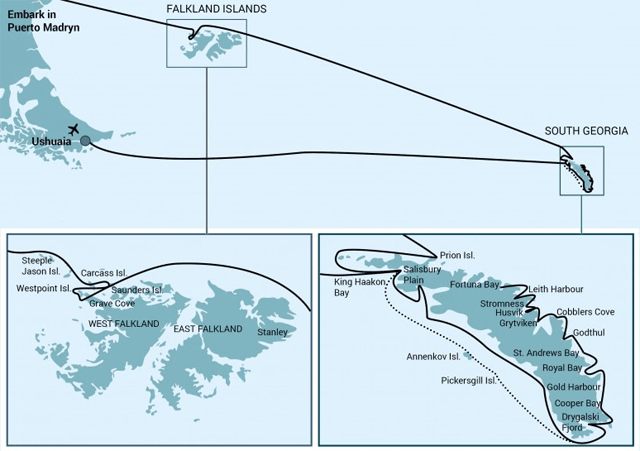HIGHLIGHTS
- Watch
several species of birds as they follow the vessel southeast, such as
albatrosses, storm petrels, shearwaters, and diving petrels
- Visit
the Falkland Islands which offer an abundance of wildlife including
many endemic species. The waters of the Falklands are also rich with
sea life, including southern sea lions and elephant seals. There is a
good chance to see both Peale’s dolphins and
Commerson’s dolphins
- Get
a chance to visit Steeple Jason and Carcass Island
- As
an alternative, you might visit Saunders Island, Westpoint Island and
Grave Cove
- En
route to South Georgia, cross the Antarctic Convergence which attracts
a multitude of seabirds near the ship, including several species of
albatross, shearwaters, petrels, prions, and skuas
- Visit
South Georgia’s breathtaking wildlife and scenery at Prion
Island, Salisbury Plain, St. Andrews Bay, Gold Harbour, Fortuna Bay,
Leith Harbour, Stromness, Husvik, Grytviken, Cobblers Cove, Godthul,
Royal Bay, Cooper Bay, Drygalski Fjord, Annenkov Island and King Haakon
Bay
- South
polar skuas and snow petrels could join the albatrosses trailing the
ship on the journey back home
DATES / RATES
Rates are listed per person
|
| Start Date | End Date | From EUR | From USD |
|---|
Rates are listed per person
|
| Start Date | End Date | From EUR | From USD |
|---|
ITINERARY
Day
1: Sandy Argentine beaches
You
embark from Puerto Madryn in the afternoon, your prow aimed for the
Falkland Islands. Golfo Nuevo is renowned for its visiting southern
right whales, so you have a good chance of spotting one as you sail
toward the open ocean.
Day
2 – 3: Sea life, sea birds
Though
you’re now at sea, there’s rarely a lonesome moment
here. Several species of bird follow the vessel southeast, such as
albatrosses, storm petrels, shearwaters, and diving petrels.
Day
4 - 5: Finding the Falklands
The
Falkland Islands offer an abundance of wildlife that is easily
approachable, though caution is always advised. These islands are
largely unknown gems with a wealth of bird life, including many endemic
species. The waters of the Falklands are also rich with sea life,
including southern sea lions and elephant seals. There is a good chance
to see both Peale’s dolphins and Commerson’s
dolphins.
During
this segment of the voyage, we aim to visit the following two sites:
Steeple Jason
– Home to the world’s largest black-browed
albatross colony (roughly 113,000), Steeple Jason is a wild and rarely
visited island buffeted by wind and waves. Weather and swell conditions
dictate the journey here.
Carcass Island
– Despite its name, this island is pleasantly rodent-free and
hence bounteous with birdlife and many endemic species. Anything from
breeding Magellanic penguins and gentoos to numerous waders and
passerine birds (including Cobb’s wrens and tussock-birds)
live here.
Other
sites that we may offer as an alternative:
Saunders Island
– On Saunders Island you can see the black-browed albatross
and its sometimes-clumsy landings, along with breeding imperial shags
and rockhopper penguins. King penguins, Magellanic penguins, and
gentoos are also found here.
Westpoint Island
– Landing in a small cove near the island's house, you will
be able to walk through the tussac grass and an abundant breeding
colony of black-browed albatrosses, where they live side by side
with rockhopper penguins.
Grave Cove
– Nesting gentoo penguins and excellent hiking opportunities
abound here, with the chance to enjoy great scenery and wildlife.
Day
6 – 7: Once more to the sea
En
route to South Georgia, you now cross the Antarctic Convergence. The
temperature cools considerably within the space of a few hours, and
nutritious water rises to the surface of the sea due to colliding water
columns. This phenomenon attracts a multitude of seabirds near the
ship, including several species of albatross, shearwaters, petrels,
prions, and skuas.
Day
8: Shag Rocks
Today
we reach the Shag Rocks, a group of six islands surrounded by
nutrient-rich waters that offer great feeding grounds for numerous
birds and whales. The islands are named after the South Georgian shag,
known for its bright blue eyes and yellow beak patch.
Day
9 – 13: South Georgia journey
In
our tour of South Georgia’s breathtaking wildlife and
scenery, we may visit the following sites. Please keep in mind that
weather conditions in this area can be challenging, largely dictating
the program.
Sites
you might visit include:
Prion Island
– The home of the great wandering albatrosses. The previous
summer’s wandering albatross chicks are almost ready to
fledge, and adults are seeking out their old partners after a year and
a half at sea.
Salisbury Plain, St. Andrews Bay,
Gold Harbour – These sites not only house the
three largest king penguin colonies in South Georgia, they’re
also three of the world’s largest breeding beaches for
southern elephant seals. Only during this time of year do they peak in
their breeding cycle. Watch the four-ton bulls keep a constant vigil
(and occasionally fight) over territories where dozens of females have
just given birth or are about to deliver. You can also see a
substantial number of Antarctic fur seals here during the breeding
season (December – January).
Fortuna Bay
– This beautiful outwash plain from Fortuna Glacier is home
to a large number of king penguins and seals. You may have the chance
to follow the final leg of Shackleton’s route to the
abandoned whaling village of Stromness. This path cuts across the
mountain pass beyond Shackleton’s Waterfall, and as the
terrain is partly swampy, be prepared to cross a few small streams.
Leith Harbour, Stromness, Husvik
– These sites remind us of the scale of the whaling industry
in the early 20th century. Elephant and fur seals breed and moult here.
Gentoo penguins also occupy the landing sites. Antarctic prions and
South Georgia dive petrels may be observed, especially in the area of
Husvik.
Grytviken
– In this abandoned whaling station, king penguins walk the
streets and elephant seals lie around like they own the place
– because they basically do. Here you might be able to see
the South Georgia Museum as well as Shackleton’s grave.
Cobblers Cove, Godthul
– Here we will try to visit Rookery Point to see macaroni
penguins. We might also encounter giant petrels, gentoo penguins,
seals, and light-mantled sooty albatrosses nesting along the coastline.
Godthul (Norwegian for “good cove”) was named by
Norwegian whalers and seal hunters.
Royal Bay (Moltke Harbour, Will
Point & Brisbane Point) – Moltke Harbour
in Royal Bay was named by the German International Polar Year
Expedition in 1882, and some of the remains of their dwellings are
still visible. The scenery of Royal Bay is amazing, with dark sandy
beaches, green tussocks, and of course, the great Ross Glacier. It may
be windy here, but the Zodiac cruising is spectacular. Roughly 30,000
pairs of king penguins also live in this area.
Cooper Bay
– A Zodiac cruise in Cooper Bay offers a good chance to see
macaroni penguins, gentoo penguins, and one of the world’s
largest chinstrap penguin rookeries. Fur and elephant seals may be seen
on the beach, while we might also spot light-mantled sooty albatrosses
gliding overhead. Antarctic terns, white-chinned petrels, and blue-eyed
shags are possible here too.
Drygalski Fjord
– This narrow waterway offers spectacular landscapes,
specifically high mountain peaks at a very close distance.
Annenkov Island
– Passing Pickersgill Islands, we reach the rarely visited
Annenkov Island, first discovered by James Cook in 1775 and later
renamed by the Russian expedition of Fabian von Bellingshausen in 1819.
This is a rocky terrain with a variety of ridges, peaks, and hills
where fossils have been found.
King Haakon Bay
– Few Antarctic locations are more steeped in expedition
history than this one. British explorer Ernest Shackleton reached King
Haakon Bay during his arduous open-boat voyage from Elephant Island,
where his crew was stranded after sea ice crushed their ship. Elephant
seals dominate these rugged beaches, and birdwatchers should keep a
lookout for South Georgia pipits, Antarctic prions, common diving
petrels, and blue petrels.
Day
14 – 17: Westward bound
South
polar skuas and snow petrels could join the albatrosses trailing our
vessel during these sea days, and we may also encounter sea ice. When
we reach the Drake Passage, you will be again greeted by the vast array
of seabirds remembered from the passage south.
Day
18: Earth’s southernmost city
You
arrive and disembark in Ushuaia, commonly held to be the
world’s most southern city. It is located on the Tierra del
Fuego archipelago, nicknamed the “End of the
World.” But despite this stopping point, the wealth of
memories you’ve made on your Antarctic expedition will travel
with you wherever your next adventure lies.
 (Click image to view Ship details)
(Click image to view Ship details)
WHAT'S INCLUDED
- Voyage
aboard the indicated vessel as indicated in the itinerary
- All
meals throughout the voyage aboard the ship including snacks, coffee
and tea.
- All
shore excursions and activities throughout the voyage by Zodiac.
- Program
of lectures by noted naturalists and leadership by experienced
expedition staff.
- Free
use of rubber boots and snowshoes.
- Luggage
transfer from pick-up point to the vessel on the day of embarkation, in
Ushuaia.
- Pre-scheduled
group transfer from the vessel to the airport in Ushuaia (directly
after disembarkation).
- All
miscellaneous service taxes and port charges throughout the programme.
- Comprehensive
pre-departure material.
Excluded
from this voyage
- Any
airfare, whether on scheduled or charter flights
- Pre-
and post- land arrangements.
- Passport
and visa expenses.
- Government
arrival and departure taxes.
- Meals
ashore.
- Baggage,
cancellation and personal insurance (which is strongly recommended).
- Excess
baggage charges and all items of a personal nature such as laundry,
bar, beverage charges and telecommunication charges.
- The
customary gratuity at the end of the voyages for stewards and other
service personnel aboard (guidelines will be provided).
- Voyage
aboard the indicated vessel as indicated in the itinerary
- All
meals throughout the voyage aboard the ship including snacks, coffee
and tea.
- All
shore excursions and activities throughout the voyage by Zodiac.
- Program
of lectures by noted naturalists and leadership by experienced
expedition staff.
- Free
use of rubber boots and snowshoes.
- Pre-scheduled
group transfer from the vessel to the airport in Ushuaia (directly
after disembarkation).
- All
miscellaneous service taxes and port charges throughout the programme.
- Comprehensive
pre-departure material.
Excluded
from this voyage
- Any
airfare, whether on scheduled or charter flights
- Pre-
and post- land arrangements.
- Passport
and visa expenses.
- Government
arrival and departure taxes.
- Meals
ashore.
- Baggage,
cancellation and personal insurance (which is strongly recommended).
- Excess
baggage charges and all items of a personal nature such as laundry,
bar, beverage charges and telecommunication charges.
- The
customary gratuity at the end of the voyages for stewards and other
service personnel aboard (guidelines will be provided).
ADVENTURE
OPTIONS
- Photo
Workshop
- Zodiac
Cruising and Shore Programs







